This paper summarizes the findings of three studies that investigated the effects of directional processing schemes on sound quality. These investigations used a double-blind design in which hearing-impaired listeners were asked to express a preference for either the ReSound Surround Sound Processor or a conventional full directional response.
Directional microphone systems in hearing instruments have proven clinical benefit for hearing in noise, yet hearing instrument wearers will often prefer the omnidirectional microphone mode over directional, even in many noisy situations.1
The explanation for users’ seemingly paradoxical preferences for a response that may not help them hear better in noise is related to how limitations of directional technology impact audibility and sound quality. Directional microphone processing results in less sensitivity for low frequency sounds. This means that low frequency sounds are amplified less and are thus less audible. To compensate for this effect, low frequency gain may be boosted to equalize the directional and omnidirectional responses. Commonly known as “equalization” or “bass boost,” this compensation strategy increases audibility of the desired signal, but also increases the audibility of the hearing instrument noise floor, resulting in poorer sound quality.
A new technology has been introduced that provides the benefits of directionality without the sound quality drawbacks. The ReSound Surround Sound Processor channels higher frequency sounds through advanced directional processing, while an omnidirectional response is maintained in the low frequencies. The frequency at which the directional and omnidirectional processing is split is calculated for each fitting based on the individual’s audiometric data and form factor specific information to ensure an optimum balance of audibility, improved signal-to-noise ratio, and sound quality.
This approach is designed to solve by-products of directional processing that have been shortcomings of even the most advanced adaptive systems, including added noise from low frequency equalization, distortion of near-field sounds (eg, own voice and wind noise), as well as disruption of the low frequency interaural time differences, which are crucial for localization. In addition, the Surround Sound Processor contributes to a more natural perception of sound by emulating the acoustic characteristics of the open ear. This processing strategy replicates directionality patterns of the unaided ear (Figure 1), contributing to a more natural perception of sound for the user.
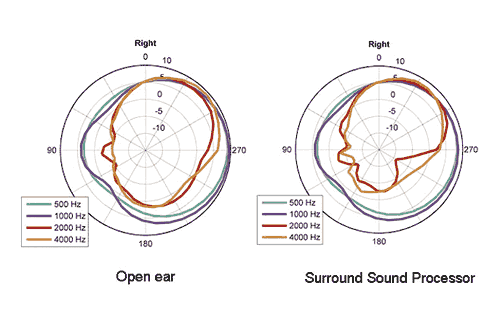
FIGURE 1. Unaided directionality patterns for four frequencies, as measured on the right ear of KEMAR. The patterns are more omnidirectional for lower frequencies, and directional for higher frequencies.
This paper summarizes the findings of three unpublished theses2,3,4 at Lessius University College in Antwerp, Belgium, which investigated the effects of directional processing schemes on sound quality. These investigations used a double-blind design in which hearing-impaired listeners expressed a preference for either the Surround Sound Processor or a conventional full directional response.
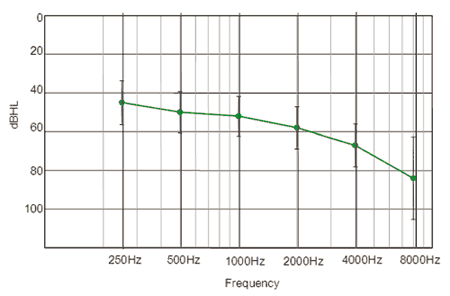
FIGURE 2. Average best ear hearing threshold levels for all participants.
Methods
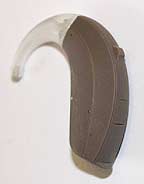
FIGURE 3. Unmarked BTE hearing instruments kept both the subjects and evaluators uninformed as to what instruments contained the different directionality programs.
A total of 23 experienced BTE hearing instrument users were fit to their best ear (Figure 2) with 4 unmarked, physically identical dual microphone BTE hearing instruments (Figure 3). Their own earmolds were used on the test devices and the non-test ear was occluded. Prior to the experiment, the gains in the test instruments were adjusted and programmed to match the participants’ personal devices. The devices were programmed by a different investigator than the one carrying out the actual listening test. In this way, neither the investigators who carried out the test nor the participants had any knowledge of how the test devices were programmed.
Each device had two programs. As shown in Table 1, three of the devices had a directional program and an omnidirectional program, and one device had conventional full directionality in one program and the Surround Sound Processor active in the other. No other features or signal processing schemes were activated in any of the instruments. The order of programs was randomized.
Participants had no prior listening experience with the test devices and all tests were done during a one-time clinic visit. In a forced-choice design, participants were asked to choose the program they judged as having the best sound quality when presented with different recorded sounds. They were seated in a sound booth with 2 speakers located at a distance of 1.5 m in front of the listener, and signals were presented at 65 dBSPL at ear level. The participants were presented with each sample for approximately 1 minute, and toggled between the programs on the device as many times as they wanted during that time. Following the presentation of each sample, participants were asked to indicate which program had the best sound quality.
Sound quality was not formally defined, so each listener used their own personal criteria in making sound quality judgments. Three different sound examples representing either music, speech, or environmental sounds were presented for a total of 9 judgments for each of the 4 hearing instrument conditions. The listening conditions did not represent environments where directionality might provide SNR benefit. This was intended to allow the listeners to focus on sound quality alone.
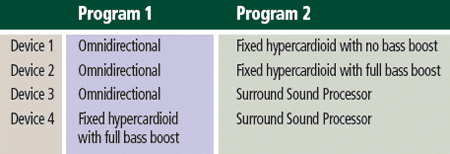
TABLE 1. Program settings for test devices. The actual order of programs was randomized to avoid order effects.
The final 9 sound samples were selected from a larger group of 69 based on judgments by 20 normal-hearing listeners to ensure that the recordings were subjectively of good quality. The following sound samples were used:
Music: All by Myself (Celine Dion); Because You Loved Me (Celine Dion); Ultimo re (Andrea Bocelli)
Running Speech Samples: Dutch; French; English
Environmental: Rain; Splashing bathwater; Wind chimes
Results and Discussion
The percentage of trials in which the omnidirectional and directional responses were preferred is shown in Figure 4. Prior to data analysis, the number of trials in which a response was preferred was converted to rationalized arcsine transform units (rau) to minimize the range of critical differences.5 Statistical significance was defined at the 0.05 level. A one-way ANOVA with Tukey-Kramer Multiple Comparisons Test revealed significant preferences for omnidirectionality over the two full directional conditions. However, there was no significant difference in preference for omnidirectional versus the Surround Sound Processor.
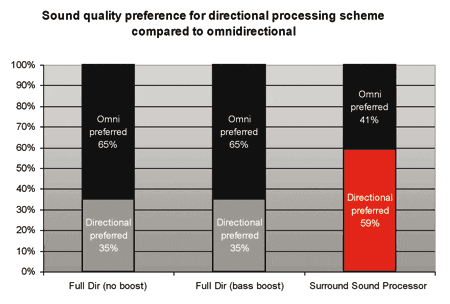
FIGURE 4. The omnidirectional responses were preferred when compared to conventional full directionality. No significant preference was found for omnidirectional versus the Surround Sound Processor.
The preferences for the omnidirectional response when compared to the two full directional conditions were not surprising. In the full directional with no bass boost condition, the inherent low frequency roll-off of the directional microphone processing would have meant less audibility for low frequency sounds than with omnidirectional processing. In terms of sound quality, this could be perceived as having less fullness or being more tinny. When the low frequencies were compensated by the bass boost, audibility for low frequencies is improved, but the sound quality can be perceived as being more noisy.
The results of the current study are similar to those reported by Preves et al.6 In their study, listeners with relatively good low frequency hearing made preference judgments comparing omnidirectional and equalized full directional responses when listening to a male speaker in quiet and in babble. Their listeners indicated a clear preference for the directional response when listening in noise, while the results when listening in quiet were equivocal.
The percentage of trials where omnidirectional was preferred did not differ significantly from the percentage of trials where the Surround Sound Processor was preferred. This suggests that the listeners did not perceive any systematic sound quality differences between the two conditions, and provides support for the assertion that the Surround Sound Processor does not negatively impact sound quality as full directionality can.
Figure 5 substantiates this idea further. In this condition, the Surround Sound Processor and full directionality with equalization for the low frequency roll-off were directly compared. Not only was the sound quality of the Surround Sound Processor preferred, but the breakdown of percentages was not significantly different than when the fixed directional conditions were compared to omnidirectional. This is strong evidence of the reliability of the participants’ subjective judgments in addition to the superiority of the Surround Sound Processor’s sound quality compared to conventional directional processing.
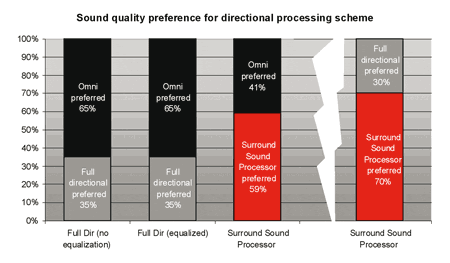
FIGURE 5. The Surround Sound Processor was significantly preferred over full directionality with bass boost in terms of sound quality.
Conclusion
These results support that the Surround Sound Processor provides better sound quality than traditional directional processing schemes with and without equalization for low-frequency roll-off. The inventive approach of differentially applying frequency-dependent directional processing to recreate the acoustic properties of the open ear allows for directional benefit without compromising on natural, comfortable sound quality. In turn, this opens the door for greater end-user benefit and satisfaction in creative applications of directionality, such as automatic microphone switching and asymmetric fitting strategies.
References
- Walden BE, Surr RT, Cord MT, Dyrlund O. Predicting hearing aid microphone preference in everyday listening. J Am Acad Audiol. 2004;15:365-396.
- Heymans L. Dubbelblind onderzoek naar de geluidskwaliteit van verschillende directionele modi bij slechthorenden en normaalhorenden, Deel 1: Vergelijking tussen omnidirectionaliteit en vaste directionaliteit zonder bass boost [Double blind study on the sound quality of directional processing schemes. Part 1: Omni-directional compared to fixed directionality without bass-boost]. Unpublished thesis. Antwerp, Belgium: Lessius University College; 2009.
- Van Der Vliet L. Dubbelblind onderzoek naar de geluidskwaliteit van verschillende directionele modi bij slechthorenden en normaalhorenden, Deel 3: Vergelijking tussen omnidirectionaliteit en vaste directionaliteit met “Bach” en tussen vaste directionaliteit met bass boost en vaste directionaliteit met “Bach.” [Double blind study on the sound quality of directional processing schemes. Part 3: Omni-directional compared to fixed directionality with surround sound processing and fixed directionality with bass boost compared to fixed directionality with surround sound processing.] Unpublished thesis. Antwerp, Belgium: Lessius Univ College; 2009.
- Van De Winkel N. Dubbelblind onderzoek naar de geluidskwaliteit van verschillende directionele modi bij slechthorenden en normaalhorenden, Deel 2: Vergelijking tussen omnidirectionaliteit en vaste directionaliteit met bass boost. [Double blind study on the sound quality of directional processing schemes. Part 2: Omni-directional compared to fixed directionality with bass-boost.] Unpublished thesis. Antwerp, Belgium: Lessius University College; 2009.
- Studebaker G. A ”rationalized” arcsine transform. J Speech Hear Res. 1985;28:455-462.
- Preves DA, Sammeth CA, Wynne KA. Field trial evaluations of a switched directional/omnidirectional in-the-ear hearing instrument. J Am Acad Audiol. 1999;10:273-284.
Citation for this article:
Groth J, Laureyns M, Piskosz M. Double-blind study indicates sound quality preference for surround sound processor. Hearing Review. 2010;17(3):36-41.






